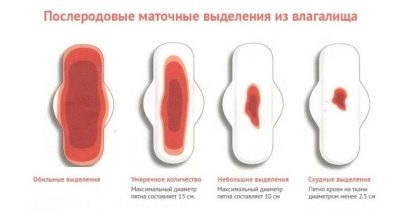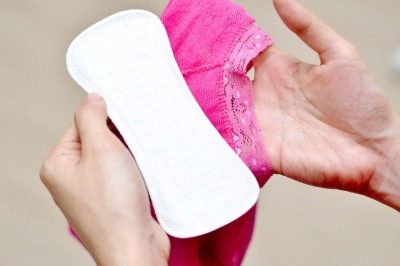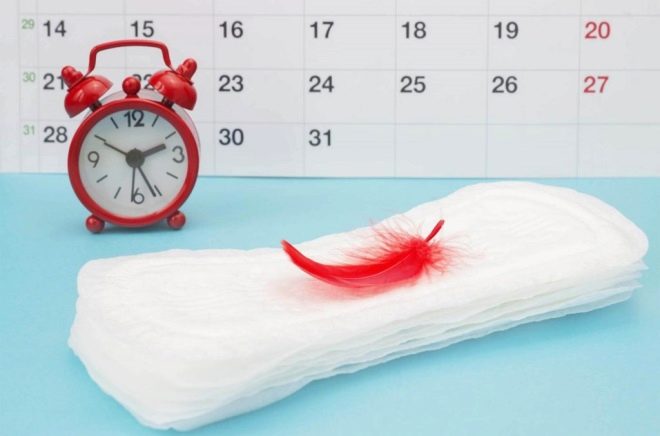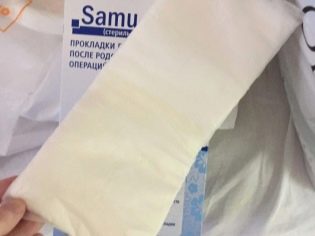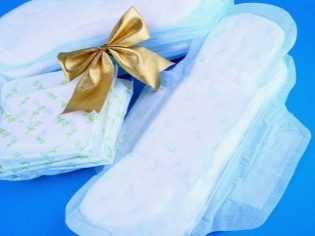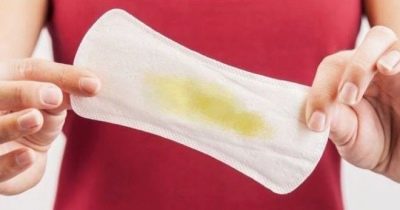What are the discharge after cesarean section?
After surgical childbirth, as well as after the usual, the woman from the genitals observed discharge. By their nature, much can be said about how the recovery process goes after the operation in a particular patient. Postpartum discharge (lochia) can both say that everything is in order with the newly-made mother and can be a signal of complications. In this article, we will consider different types of discharge after surgical delivery and tell you how soon they should be completed.
The reasons
Both after natural childbirth and after cesarean section, discharge from the genital organs indicates the process of the reverse development of the uterus. Involution begins immediately after surgeons remove the baby's placenta from the mother’s womb and place surgical sutures.
From the moment of detection on the rapid test of two cherished strips until the day of the delivery operation, the female reproductive organ increases 500 times. The smooth muscles of the uterus stretch, the ligaments lengthen and coarsen. The placenta, which nourishes the baby and supplies it with the necessary oxygen for life and development, firmly grows into the uterine wall with a network of blood vessels.
Blood discharge after physiological delivery is caused only by the separation of the placenta and the violation of this “joint” blood vascular system. After a cesarean section, the injury is more significant: in order to penetrate into the uterus, it is necessary to make an incision on its wall. It also injures the blood vessels of the reproductive organ. Coupled with bleeding after separation of the placenta Lochia become more abundant and more intense just after surgical labor.
The uterus itself can not decrease immediately after the baby is removed. It still remains large for some time, although now it’s more like an empty bag from which all the contents were taken out. It will decrease to almost the original size, but the process of involution takes time.
Involution will be accompanied by cramps, in nature resembling contractions. They are called uterine contraction. Contractions after cesarean are not as active as after physiological labor, but because a woman receives scheduling injections of contraction drugs on a mandatory basis. A few minutes after the introduction of "Oxytocin" or another drug based on it, the uterus begins to actively contract, which is accompanied by increased secretions from the genital organs - no need to be afraid.
Both the woman herself and her doctor should be very attentive to the nature of the Lohii, both at an early stage after the operation and after discharge home. In order to find out if there are grounds for anxiety, you need to know how much discharge after surgical labor should be normal.
What should be?
Abundant bleeding for the first days after surgery is the absolute norm. Blood is excreted from the impaired circulatory grid at the site of attachment of the placenta, as well as from a wound in the incision area of the uterus. By the end of the first day, the inner wound begins to fall, with this help her fibrin threads, which cover the wound surface and prevent a large loss of blood. This mechanism is natural, natural, it is impossible to influence it.
Therefore, in the first hours after the operation, the excretions are scarlet, red, and after 10–12 hours, blood clots can be detected in them (the work of fibrinogen). The presence of clots of different size and number neither on the second nor on the third day after the operation should not confuse the puerperal. Their output, on the contrary, is considered a favorable sign - the uterus involution.
If a laboratory smear test is done during this period, a high rate of red blood cells in vaginal secretions will be the absolute norm.
By the time of discharge from the maternity hospital (and after the operation today they are discharged on the fifth day), the lochia is usually somewhat modified. They still remain bloody, but the content of serous serum increases. On the sanitary pad begins to determine a significant amount of mucus mucus. Blood clots at this stage should no longer be.
A laboratory study of smear these days shows the presence of an impressive number of leukocytes and epithelial cells, which are dead myocytes - uterine cells, which were injured when the wall was dissected with a scalpel.
Even more mucus in the discharge normally appears one week after surgery. This is cervical mucus, which begins to be produced in large quantities. Often at this stage, women are frightened to find small brown fragments resembling worms on a gasket. There are no reasons for anxiety: these fragments are the tips of the surgical self-absorbable sutures, with which the internal suture is applied. This does not mean that the seam is divergent. - just particles of threads that were not directly included in the uterus tissue, disappear and are excreted by the body. The more complex was the internal suture (double-row, three-row), the greater the number of brown fragments can be determined in the cervical mucus.
The color and consistency of the discharge will change almost every day. In a month, the lochia will become more scarce. Moderate, uniform discharge of pinkish or yellow color can persist up to one and a half months after surgery. By week 7–8, they become normal, as they should be before pregnancy.
The bleeding ends by 6–7 weeks, but doctors recommend waiting a couple more weeks after the lochia stops before starting sex life.
The total amount of blood loss during the period of postpartum discharge is quite difficult to calculate. According to some reports, it exceeds one and a half kilograms of net weight from body weight, taking into account the reduction of the uterus, when it ends.
Recommendations
The sooner a woman gets out of bed, the better blood clots will come out and the reproductive organ will contract. That is why getting up and moving (without too much fanaticism, naturally) is recommended already 10–12 hours after the operation. Early attachment of the baby to the breast is also an additional favorable moment, because when breastfeeding the amount of oxytocin in the body increases, the uterus begins to contract more actively.
In the first three days after surgery It is important to prevent wound infection and ascending vaginal infection. That is why women are urged to use only hospital bedplates, which are sterile. They need to be changed every three hours. From the moment a woman learns to walk, she can rinse 2-3 times a day, washing the external genitalia and completely eliminating the ingress of water into the vagina. It is strictly prohibited to use factory sanitary pads at this stage.
On the fifth day after surgery, you can use any gaskets, most importantly, do not forget to change them more often. A woman can go on daily hygienic thin pads immediately after the spotting stops.
In addition to controlling the color, quantity and consistency of vaginal secretions, it is important to measure body temperature in the maternity hospital and at home after discharge. This is an important sign of the state of the puerperal. Quite often, it is her sharp increase, long-lasting nature that act as the first signs of the onset of inflammation (discharge of the corresponding nature will appear a little later).
Do not hesitate to ask questions to the medical staff of the hospital. Lochia and their character after operative labor is a very important topic, and therefore there should not be anything unsaid in it. Also, it is not necessary to hide from the doctor any deviations of discharge from the norm described above. The fear that the statement may be postponed, makes women sometimes reckless.
It will not take long to hide the complications that have begun. And even if it can be done before discharge, then after a few days a woman can be in the hospital again, but this time without a child, since they are admitted to the gynecological department with postpartum complications.
Deviations from the norm
Pathological discharge most often speaks of the complications of the operation or the exacerbation of chronic diseases in the puerperal. There is always a chance of complications. No clinic, even if the operation is paid, will never be able to guarantee that everything will go smoothly.
During the operation, abnormal situations may occur in which, for example, a vascular node will be injured, and also in the very early postoperative period, bleeding from the genitals will be abundant, massive, incessant. The absence of discharge or very scanty discharge in the first three days may indicate hypotension or atony of the uterus, when its contraction does not occur or it occurs extremely sluggishly and slowly. In this case, blood clots may also not be observed.
Even pathogenic microorganisms can get into the uterine cavity, even in a sterile operating room, infection can occur in the postoperative period, and then internal inflammation begins, which necessarily manifests itself by a change in the nature of the secretions, high fever, and deterioration of health in general.
While the woman is in the hospital, doctors will be able to pay attention to changes in her condition. But after discharge home, control over the discharge should not weaken at all. In all cases, you need to consult a doctor - self-treatment in this matter is unacceptable. Here are common pathological situations:
- severe bleeding has opened after discharge has temporarily stopped;
- blood discharge began with clots after discharge home;
- the temperature has risen on the background of any discharge;
- little discharge in the first days or their earlier cessation (a week after the operation);
- strange-colored liquid with an unpleasant odor;
- lochia are protracted: discharge continues 2 months after cesarean section;
- there are impurities, flakes, light clots in the secretions;
- I have a stomachache;
- purulent, green, gray discharges with a sharp unpleasant odor;
- there is blood or other discharge from the suture on the abdominal wall after discharge.
Pathological secretions do not pass by themselves, so you should not count on it.
What do they mean?
What can be said about certain deviations in the nature of the discharge, only a doctor can answer, who will order an examination and take tests from the newly made mommy. But a few common problems in the trial will be described.
- Pink mucous membranes. This type of lochia is the norm for 5–15 days after surgery, but after a month or two it is a sign of slow healing of the internal scar. It is possible that a woman's body rejects surgical suture material at the immune level.Also, such secretions can occur in women who, contrary to the recommendations of the doctor, began early sexual life, not waiting for the end of lochia and the healing of the inner scar. Upon detection of such discharge, it is obligatory to consult a doctor, to pass a smear and an ultrasound of an internal suture.
- Yellow green. This character have a selection of endometritis and any other started the inflammatory process. Usually they have an unpleasant fishy smell, itching and burning in the perineum, abdominal pain, high fever may occur. The woman is urgently shown hospitalization and a long course of treatment.
- Watery. Such secretions are also a rather alarming sign. They can talk about circulatory disorders in the uterus. The watery consistency in this case is a sign of transudate discharge. If watery lochia without a special color or slightly yellowish is accompanied by an unpleasant smell, you should not postpone the visit to the doctor.
- White thick. It may be a sign of vaginal dysbiosis, as well as a sign of thrush, if accompanied by itching and burning. After surgery, the woman’s immunity weakens significantly, and the manifestation of thrush may well occur. Do not self-medicate: many vaginal means, which were used even during pregnancy, after surgery can be harmful until the scarring of the internal uterine scar is complete. Therefore, it is best to consult a doctor.
Memo for the puerperal
Of course, I would like the discharge after cesarean to be short and not darken the happiness of motherhood, but they are inevitable, and you need to get used to this thought. It is important not only to control the nature of the discharge, but also to do everything possible to reduce the likelihood of possible complications.
Do not lift weights
If you want the inner scar to form a wealthy one and allow you to have more children, as well as to eliminate the possibility of its rupture, discrepancy, strain, you need to understand that weight lifting is strictly contraindicated. Moreover, on the first day it is better to be limited to the bowl of soup in general, and after discharge the maximum weight for manual lifting should not exceed 4 kilograms.
The restriction should be taken for granted after the release of the Lohyas is complete. So, at least up to six months, neither press the press, nor squat, nor jump a woman. To carry heavy bags or strollers on the stairs, there can be no talk at all.
Do not rush into sex
Returning to sexual pleasures after cesarean section is possible only after the puerperal discharge from the genitals is completely completed and the initial healing of the internal suture is completed. Term restrictions - 2 months. If the discharge during this period does not stop, you need to consult a doctor and postpone the intimate life for some more time, which the specialist will indicate.
Early sex is fraught with the development of infection, because the penis, even in a condom, is not a model of sterility. Conditionally pathogenic microorganisms and pathogens can easily get into the genital tract and cause severe inflammation of the reproductive organs or the area of the wound lesion.
Intense (and not intensive) frictions can cause mechanical damage to the internal scar, and orgasm and sexual arousal increase blood flow to the smooth muscles of the uterus, which can cause the formation of an insolvent internal scar, enhance blood discharge, keloid scar formation.
Control the menstrual cycle
An important role in preventing complications is contraception. After the discharge stops, the couple must use condoms.After 2–7 months, menstruation is usually established, after which you can choose with the doctor any of the existing methods of contraception — it is strongly recommended that you not get pregnant again for 2 years.
Follow the vaginal secretion and need after the end of lohii. It is possible that after a few days or weeks after that the periods will begin. They will be almost as they were before pregnancy, except that there will be fewer clots in the menstrual flow, since the endometrium has not yet fully recovered. It is possible that the first menstruation will be more scarce than usual, their short duration will also be considered normal - not six days, as before, but only 3-4 days.
Gradually, menstruation will return to the normal schedule. Neither their duration, nor their nature, nor their periodicity, can a caesarean section totally affect them. Within six months, the cycle will be restored and become the same.
Do not use tampons
Until lochia stopped, it is strictly forbidden to use tampons instead of sanitary pads. With the swab does not occur free release of vaginal secretions out, and this "stagnation" can cause a serious inflammatory process.
Syringing in the first six months, inserting vaginal suppositories (except those recommended by the doctor) and introducing vaginal creams is also contraindicated.
Reviews
The average duration of discharge after cesarean, according to reviews, is almost the same as after natural childbirth. But their color and smell are important, which experienced mothers do not advise to ignore.
How the postpartum period should go, see the next video.


